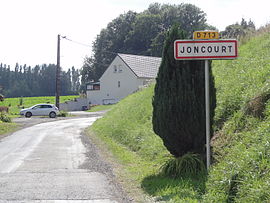Joncourt
This article may be expanded with text translated from the corresponding article in French. (December 2008) Click [show] for important translation instructions.
|
Joncourt | |
|---|---|
Commune | |
 The road into Joncourt | |
 Joncourt | |
| Coordinates: 49°57′24″N 3°18′01″E / 49.9567°N 3.3003°ECoordinates: 49°57′24″N 3°18′01″E / 49.9567°N 3.3003°E | |
| Country | France |
| Region | Hauts-de-France |
| Department | Aisne |
| Arrondissement | Saint-Quentin |
| Canton | Bohain-en-Vermandois |
| Government | |
| • Mayor (2020–2026) | Philippe Ricour[1] |
| Area 1 | 7.25 km2 (2.80 sq mi) |
| Population (Jan. 2018)[2] | 305 |
| • Density | 42/km2 (110/sq mi) |
| Time zone | UTC+01:00 (CET) |
| • Summer (DST) | UTC+02:00 (CEST) |
| INSEE/Postal code | 02392 /02420 |
| Elevation | 108–153 m (354–502 ft) (avg. 145 m or 476 ft) |
| 1 French Land Register data, which excludes lakes, ponds, glaciers > 1 km2 (0.386 sq mi or 247 acres) and river estuaries. | |
Joncourt is a commune in the Aisne department in Hauts-de-France in northern France.
It lies near the St. Quentin Canal.
History[]
On 1 October 1918 during World War I, a battle was fought there that was described by the Allied media at that time as "the Miracle of the War", the 46th (North Midland) Division broke through the Hindenburg Line near the town at the canal. For his courage and leadership in the Joncourt action, the poet Wilfred Owen was posthumously awarded the Military Cross.
Population[]
| Year | Pop. | ±% |
|---|---|---|
| 1962 | 313 | — |
| 1968 | 278 | −11.2% |
| 1975 | 250 | −10.1% |
| 1982 | 259 | +3.6% |
| 1990 | 302 | +16.6% |
| 1999 | 332 | +9.9% |
| 2008 | 326 | −1.8% |
| 2012 | 317 | −2.8% |
See also[]
References[]
- ^ "Répertoire national des élus: les maires". data.gouv.fr, Plateforme ouverte des données publiques françaises (in French). 9 August 2021.
- ^ "Populations légales 2018". The National Institute of Statistics and Economic Studies. 28 December 2020.
| Wikimedia Commons has media related to Joncourt. |
Categories:
- Communes of Aisne
- Saint-Quentin arrondissement geography stubs


